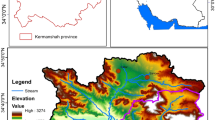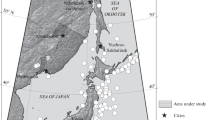Abstract
By applying fractal geometry analysis to the drainage network of three large watercourses in America and Europe, we have calculated for the first time their fractal dimension. The aim is to interpret the geomorphologic characteristics to better understand the morphoevolutionary processes of these fluvial morphotypes; to identify and discriminate geomorphic phenomena responsible for any difference or convergence of a fractal dimension; to classify hydrographic patterns, and finally to compare the fractal degree with some geomorphic-quantitative indexes. The analyzed catchment of Russian (California, USA), Ebro (Spain), and Volturno (Italy) rivers are situated in Mediterranean-climate regions sensu Köppen, but with different geologic context and tectonic styles. Results show fractal dimensions ranging from 1.08 to 1.50. According to the geological setting and geomorphic indexes of these basins, the lower fractal degree indicates a prevailing tectonics, active or not, while the higher degree indicates the stronger erosion processes on inherited landscapes.







Similar content being viewed by others
References
Andrews, W.M. Jr. (2006), Geologic control on Plio-Pleistocene drainage evolution of the Kentucky River in central Kentucky, Kentucky Geological Survey, University of Kentucky (USA), Thesis 4, Series XII, pp. 216.
Bartolini, C. (2012), Is the morphogenetic role of tectonics overemphasized at times?, Boll. Geof. Teor. Appl. 53(4), 459–470.
Batalla, R.J., Gómez, C.M., and Kondolf, G.M. (2004), Reservoir-induced hydrological changes in the Ebro River basin, J. Hydrol. 290, 117–136.
Burbank, D.W., Anderson, R.S., Tectonic Geomorphology, 2nd ed. (Wiley-Blackwell., Oxford 2011).
D’Alessandro, L., De Pippo, T., Donadio, C., Mazzarella, A., and Miccadei, E. (2006), Fractal dimension in Italy: a geomorphological key to interpretation, Zeit. Geom. N. F. 50(4), 479–499.
De Martonne, E. (1941), Nouvelle carte mondiale de l’indice d’ariditè, La meteorologie 1, 3–20.
De Pippo, T., Donadio, C., Mazzarella, A., Paolillo, G., and Pennetta, M. (2003), Fractal geometry applied to coastal and submarine features, Zeit. Geom. N. F. 48(2), 185–199.
De Pippo, T., Donadio, C., Pennetta, M., Petrosino, C., Terlizzi, F., and Valente, A. (2008), Coastal hazard assessment and mapping in Northern Campania, Italy, Geomorphology 97, 451–466.
Deitch, M.J., and Kondolf, G.M. (2012), Consequences of variations in magnitude and duration of an instream environmental flow threshold across a longitudinal gradient, J. Hydrol. 420–421, 17–24.
Del Monte, M., Fredi, P., Lupia Palmieri, E., and Salvini, F. (1999), Fractal analysis to define drainage network geometry, Boll. Soc. Geol. It. 118, 167–177.
Del Monte, M., Fredi, P., Lupia Palmieri, E., and Sbarra, P. (2007), Some relations between fractal dimension of drainage network and geomorphology of drainage basins, Transactions Jap. Geom. Union 28(1), 1–21.
Fournier, F., Climat et Erosion (PUF, París 1960).
Gao, J., and Xia, Z. (1996), Fractals in physical geography, Progress Phys. Geogr. 20(2), 178–191.
Gardiner, V., and Park, C. (1978), Drainage basin morphometry: review and assessment, Progress Phys. Geogr. 2, 1–35.
Garnett, P.W. (1986), River meanders and channel size, J. Hydrol. 88, 147–164.
Grassberger, P., and Procaccia, I. (1983), Characterization of strange attractors, Phys. Rev. Lett. 50, 346–349.
Horton, R.E. (1945), Erosional development of streams and their drainage basins: hydrophysical approach to quantitative morphology, Geol. Soc. Am. Bull. 56, 275–370.
Howard, A.D. (1967), Drainage analysis in geologic interpretation: a summation, Amer. Ass. of Petroleum Geologist Bull. 51, 2246–2259.
James, J.W. (1966), A modified Koeppen classification of California’s climates according to recent data, California Geographer 7, 1–12 + map.
Jones, S.J. (2004), Tectonic controls on drainage evolution and development of terminal alluvial fans, southern Pyrenees, Spain, Terra Nova 16, 121–127.
Klinkenberg, B. (1992), Fractal and morphometric measures: is there a relationship?, In Fractals in Geomorphology (eds. Snow R.S. and Mayer L.), Geomorphology 5, 5–20.
Klinkenberg, B. (1994), A review of methods used to determine the fractal dimension of linear features, Math., Geol. 26, 23–46.
Klinkenberg, B., and Clarke K.C., Exploring the fractal mountains, In Automated Pattern Analysis in Petroleum Exploration (eds. Palaz I. and Sengupta S.) (Springer-Verlag, New York 1992), pp. 201–212.
Klinkenberg, B., and Goodchild, M. (1994), The fractal properties of topography: a comparison of methods, Earth Proc. Landf. 17, 217–234.
Kondolf, G.M., and Batalla, R.J., Hydrological effects of dams and water diversions on rivers of Mediterranean-climate regions: examples from California, In Catchment Dynamics and River Processes: Mediterranean and Other Climate Regions (eds. Garcia C. and Batalla R.J.) (Elsevier, Amsterdam 2005) pp. 197–211.
Kondolf, G.M., Montgomery, D.R., Piégay, H., and Schmitt, L. (2003), Geomorphic classification of rivers and streams, In Tools in Fluvial Geomorphology (eds. Kondolf G.M. and Piégay H.) (John Wiley & Sons, Chichester 2003) pp. 171–204.
Köppen, W., and Geiger, R., Handbuch der Klimatologie. Vol. 1, Part C (Gerbrüder Borntraeger, Berlin 1936).
La Barbera, P., and Rosso, R. (1989), On the fractal dimension of stream networks, Water Resources Res. 25, 735–741.
Luongo, G., Mazzarella, A., and Di Donna, G. (2000), Multifractal characterization of Vesuvio lava-flow margins and its implications, J. Volc. Geotherm. Res. 101, 307–311.
Magdaleno, F., Donadio, C., and Kondolf, G.M. (2014), 30 year response of a Mediterranean river to damming in California, USA, Hydrological Sciences Journal (submitted).
Magdaleno, F., Fernández, J.A., and Merino, S. (2012), The Ebro River in the 20th century or the ecomorphological transformation of a large and dynamic Mediterranean channel. Earth Surf. Proc. Landf. 37(5), 486–498.
Mandelbrot, B.B. (1967), How long is the coast of Britain? Statistical similarity and fractal dimension, Science 155, 636–638.
Mandelbrot, B.B. (1975), Stochastic model ìs of the Earth’s relief, the shape and the fractal dimension of the coastal lines, and the number area rule for the islands, Proc. Nat. Acad. Sc. USA 72, 3825–3828.
Mandelbrot, B.B., Gli oggetti frattali: forma, caso e dimensione (G. Einaudi ed., Torino 1987).
Mandelbrot, B.B., The Fractal Geometry of Nature (Freeman and Co., New York 1983).
Mazzarella, A. (1999), Multifractal dynamic rainfall processes in Italy, Theor. Appl. Climatol. 63, 73–78.
Mazzarella, A., and Tranfaglia, G. (2000), The fractal characterisation of geophysical measuring networks and its implications for an optimal location of additive stations: an application to a rain-gauge network, Theor. Appl. Climatol. 65, 157–163.
Nagatani, T. (1993), Dynamic scaling of river-size distribution in the Scheidegger’s river network model, Fractals 1, 247–252.
Peckham, S.D. (1995), New results for self-similar trees with applications to river networks, Water Resources Res. 31(4), 1023–1029.
Pennetta, M., Corbelli, V., Esposito, P., Gattullo, V., and Nappi, R. (2011), Environmental impact of coastal dunes in the area located to the left of the Garigliano river mouth (Campany, Italy). J. Coastal Res. SI 61, 421–427.
Perron, J.T., Kirchner, J.W., and Dietrich, W.E. (2009), Formation of evenly spaced ridges and valley, Nature Letters 460, 502–505.
Pinna, M., Climatologia (Utet, Torino 1977).
Rodríguez-Iturbe, I., and Rinaldo, A., Fractal River Basins. Chance and Self-Organization (Cambridge University Press, UK 2001).
Saa, A., Gascó, G., Grau, J. B., Antón, J.M., and Tarquis, A.M. (2007), Comparison of gliding box and box-counting methods in river network analysis, Nonlinear Processes in Geophysics 14(5), 603–613.
Shen, X.H., Zou, L.J., Zhang, G.F., Su, N., Wu, W.Y., and Yang, S.F. (2011), Fractal characteristics of the main channel of Yellow River and its relation to regional tectonic evolution. Geomorphology 127, 64–70.
Snow, R.S. (1989), Fractal sinuosity of stream channels, Pure Appl. Geophys. 131, 99–109.
Strahler, A.N. (1957), Quantitative analysis of watershed geomorphology, Trans. Am. Geophys. Un. 38, 913–920.
Tokunaga, E. (1978), Consideration on the composition of drainage networks and their evolution, Geograph. Rep. Tokyo Metro. Univ. 13, 1–27.
Turcotte, D.L., Fractals and Chaos in Geology and Geophysics (Cambridge University Press, UK 1997).
Xiao, Y., and Klinkenberg, B. (1993), Topographic characterization for geographic modeling, Proc. GIS’93, Vancouver, 883–898.
Author information
Authors and Affiliations
Corresponding author
Rights and permissions
About this article
Cite this article
Donadio, C., Magdaleno, F., Mazzarella, A. et al. Fractal Dimension of the Hydrographic Pattern of Three Large Rivers in the Mediterranean Morphoclimatic System: Geomorphologic Interpretation of Russian (USA), Ebro (Spain) and Volturno (Italy) Fluvial Geometry. Pure Appl. Geophys. 172, 1975–1984 (2015). https://doi.org/10.1007/s00024-014-0910-z
Received:
Revised:
Accepted:
Published:
Issue Date:
DOI: https://doi.org/10.1007/s00024-014-0910-z




